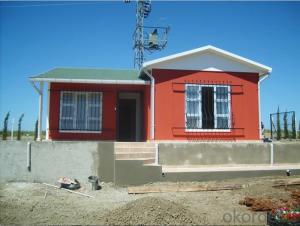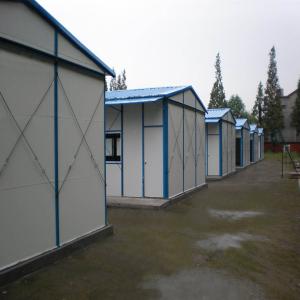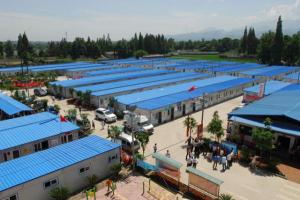Well-designed Prefabricated house
- Loading Port:
- China Main Port
- Payment Terms:
- TT OR LC
- Min Order Qty:
- -
- Supply Capability:
- -
OKorder Service Pledge
OKorder Financial Service
You Might Also Like
Specifications
Specifications prefabricated homes
1.Qualified material
2.Flexible design
3.Fast installation
prefabricated steel building Feature:
* Prefabrication, easy to install and disassemble
* Precision works, long life-span up to 15 years for use
* Lightness, easy to transport and relocate
* Using several times and recycling, economy and environment friendly
Prefab house Main material list as following:
Wall: 50mm/75mm thick EPS/Rockwool/PU sandwich panel
Roof: 50mm/75mm thick EPS/Rockwool/PU corrugated sandwich panel
Window: UPVC or Aluminum sliding window
Door: aluminum frame with panel same as wall panels(security door as optional)
Prefab house Joint material: steel column/aluminum alloy
1. Free from the damages by inspects, such as white ants and so on
2. Steel code: Q345, Q235
3. Designed life span: more than 30 years;
4. Green and environment-friendly materials used;
5. Seismic resistance up to 8 magnitudes
6. Safe---Able to stands for maximum 55 m/s typhoon
7. Advanced roof and wall cladding material guarantee excellent acoustic insulation, less 65% energy consumption than the concrete structure.
8. Additional 10%-15% net area compared to the traditional building, air cavity between the cladding and main structure guarantees the comfortable indoor space.
Prefab house advantage
1. Easy and quick to install;
2. Excellent load and span capabilities;
3. Significant savings in site installation costs;
4. Panel comes in a range of aesthetically pleasuring colors;
5. Energy saving thermal insulation;
6. Superior air tightness for controlled environments;
7. Good reactions to fire properties;
8. Durable, long lasting, stood the test of time in the extremes of harsh climate
- Q:Are container houses suitable for communal living spaces?
- Depending on a variety of factors, container houses may be a viable choice for communal living areas. Primarily, container houses offer extensive customization options, enabling the creation of larger shared spaces such as communal areas, kitchens, and bathrooms, which are essential for communal living. The modular design of container houses also allows for easy expansion or reconfiguration of the living space as the community's requirements evolve. Container houses frequently employ sustainable materials, like recycled shipping containers, aligning well with the values of eco-friendly communal living communities that prioritize minimizing environmental impact. Furthermore, container houses can be equipped with energy-efficient systems such as solar panels and rainwater harvesting, further bolstering their sustainability. Moreover, container houses are generally more cost-effective compared to traditional construction methods, rendering them a more affordable choice for communal living spaces. This proves particularly advantageous for communities with limited resources or those looking to establish affordable housing options. However, it is essential to consider some potential challenges. Although container houses offer a distinctive and innovative living experience, they may not suit everyone's taste or preferences. Some individuals might find the industrial aesthetic of container houses less appealing when compared to conventional homes. Additionally, sound insulation can be a concern in container houses, especially when taking into account the potential noise generated by a large number of residents living in close proximity. Another aspect to consider is the availability of land and the necessary permits. Depending on the location, container houses may require adherence to specific zoning regulations or building codes. It is crucial to ensure that the communal living space complies with all legal requirements, including safety standards and access to necessary utilities. In conclusion, due to their customizability, sustainability, and affordability, container houses can be a suitable option for communal living spaces. Nonetheless, it is vital to carefully consider the specific needs and preferences of the community, as well as legal requirements and potential challenges, before finalizing container houses as the housing solution for a communal living space.
- Q:Can container houses be designed for solar power?
- Yes, container houses can definitely be designed to incorporate solar power systems. The flat roof surface of container houses provides an ideal platform for installing solar panels, allowing them to harness solar energy and generate electricity to power the house. Additionally, the modular nature of container houses makes it easier to integrate solar power systems into their design, making them a sustainable and eco-friendly housing option.
- Q:Are container houses suitable for remote educational facilities?
- Yes, container houses can be suitable for remote educational facilities. They are cost-effective, portable, and can be easily assembled and disassembled, making them ideal for remote areas where traditional construction may be difficult or expensive. Additionally, container houses can be customized to include necessary amenities such as classrooms, libraries, and computer labs, providing a suitable learning environment for students in remote locations.
- Q:How long do container houses last?
- Container houses can last for several decades, typically around 25 to 30 years, depending on various factors such as maintenance, climate conditions, and the quality of construction materials used.
- Q:Are container houses suitable for tiny house living?
- Tiny house living can indeed be suitable for container houses. Constructed using shipping containers, these homes boast sturdiness, durability, and easy transportability. They bring forth numerous advantages when it comes to tiny house living. First and foremost, container houses are cost-effective. Compared to conventional building materials, shipping containers are reasonably priced and easily accessible. This makes them an affordable choice for individuals seeking a tiny house lifestyle. Secondly, container houses offer immense customization opportunities. By employing some creativity and craftsmanship, shipping containers can be transformed into functional and comfortable living spaces. They can be designed to accommodate all essential amenities, including kitchens, bathrooms, bedrooms, and living areas. Furthermore, container houses are environmentally friendly. By repurposing shipping containers, we contribute to waste reduction and the recycling of materials that would otherwise remain unused. This renders container houses an environmentally sustainable option for tiny house living. Moreover, container houses are portable. The transportability of shipping containers allows for easy relocation to different areas, granting the ability to change scenery or move without undertaking the construction of an entirely new house. Nevertheless, it is essential to consider potential challenges. Container houses may require insulation to regulate temperature, as metal containers can be susceptible to extreme heat or cold. Additionally, the size of shipping containers may limit space for certain individuals or families, as they typically provide less room than other tiny house designs. To conclude, container houses offer a suitable alternative for tiny house living. They offer affordability, customization possibilities, sustainability, and portability. However, it is crucial to carefully evaluate personal needs and requirements before determining whether a container house is the ideal choice.
- Q:Are container houses suitable for areas with limited access to medical facilities?
- Container houses can be a suitable housing option for areas with limited access to medical facilities. These houses are sturdy, cost-effective, and can be easily transported to remote locations. In such areas, where conventional housing options may be limited, container houses can provide a safe and comfortable living space. However, it is important to consider the specific needs of individuals living in these areas, especially in terms of medical care. While container houses can offer decent living conditions, they do not address the lack of medical facilities directly. It is crucial to provide alternative solutions to ensure the availability of medical aid in these areas. One possible approach would be to establish mobile medical clinics or telemedicine services to bridge the gap between container houses and medical facilities. These initiatives can provide basic healthcare services, consultations, and emergency assistance to the residents. Additionally, training local healthcare workers and equipping them with necessary medical supplies can also improve the healthcare accessibility in these areas. Ultimately, while container houses can provide suitable living spaces, it is essential to address the larger issue of limited access to medical facilities. By implementing comprehensive strategies that combine alternative healthcare options with container housing, we can ensure that individuals in these areas have both adequate housing and access to medical care.
- Q:Are container houses suitable for educational or training centers?
- Yes, container houses can be suitable for educational or training centers. Container houses have gained popularity as an alternative and sustainable building solution due to their affordability, versatility, and ease of construction. These factors make them well-suited for educational or training centers, where limited budgets and quick construction timelines are often a concern. Container houses can be easily customized to meet the specific needs of an educational or training center. They can be designed to include classrooms, offices, meeting rooms, laboratories, and other necessary facilities. The modular nature of containers also allows for easy expansion or reconfiguration as the needs of the center evolve over time. Furthermore, container houses can be equipped with necessary amenities such as heating, cooling, electricity, and plumbing, ensuring a comfortable and functional learning environment. They can also be fitted with insulation to provide a suitable environment for all seasons. Additionally, container houses are environmentally friendly as they make use of recycled shipping containers, contributing to the reduction of carbon footprint. This can align with the educational or training center's sustainability goals and serve as a practical example for students or trainees. In conclusion, container houses are a viable and suitable option for educational or training centers. They offer cost-effective, customizable, and sustainable solutions, making them an attractive choice for institutions looking to establish or expand their facilities.
- Q:Are container houses suitable for remote locations?
- Yes, container houses are suitable for remote locations. These structures are designed to be portable and easily transported to various locations, making them ideal for remote areas that are difficult to access. They can be transported by truck, ship, or even helicopter, depending on the location. Additionally, container houses are built to withstand harsh weather conditions, including extreme temperatures and high winds, making them suitable for remote areas that may experience challenging weather patterns. Furthermore, container houses can be customized and modified to meet the specific needs of the remote location, such as incorporating solar panels for off-grid living or adding insulation for colder climates. Their compact size also makes them easier to set up and maintain in remote locations. Overall, container houses offer a practical and efficient housing solution for remote areas.
- Q:Can container houses be designed with a sustainable waste management system?
- Yes, container houses can be designed with a sustainable waste management system. By incorporating composting toilets, greywater recycling systems, and efficient waste separation and recycling practices, container houses can minimize their environmental impact and contribute to sustainable waste management. Additionally, using eco-friendly construction materials and implementing renewable energy systems can further enhance the sustainability of container houses.
- Q:Can container houses be designed with a rooftop garden?
- Yes, container houses can be designed with a rooftop garden. The structure and versatility of container houses allow for the installation of a rooftop garden, which can provide additional green space, promote sustainability, and enhance the overall aesthetic of the house.
1. Manufacturer Overview |
|
|---|---|
| Location | |
| Year Established | |
| Annual Output Value | |
| Main Markets | |
| Company Certifications | |
2. Manufacturer Certificates |
|
|---|---|
| a) Certification Name | |
| Range | |
| Reference | |
| Validity Period | |
3. Manufacturer Capability |
|
|---|---|
| a)Trade Capacity | |
| Nearest Port | |
| Export Percentage | |
| No.of Employees in Trade Department | |
| Language Spoken: | |
| b)Factory Information | |
| Factory Size: | |
| No. of Production Lines | |
| Contract Manufacturing | |
| Product Price Range | |
Send your message to us
Well-designed Prefabricated house
- Loading Port:
- China Main Port
- Payment Terms:
- TT OR LC
- Min Order Qty:
- -
- Supply Capability:
- -
OKorder Service Pledge
OKorder Financial Service
Similar products
New products
Hot products
Related keywords



























